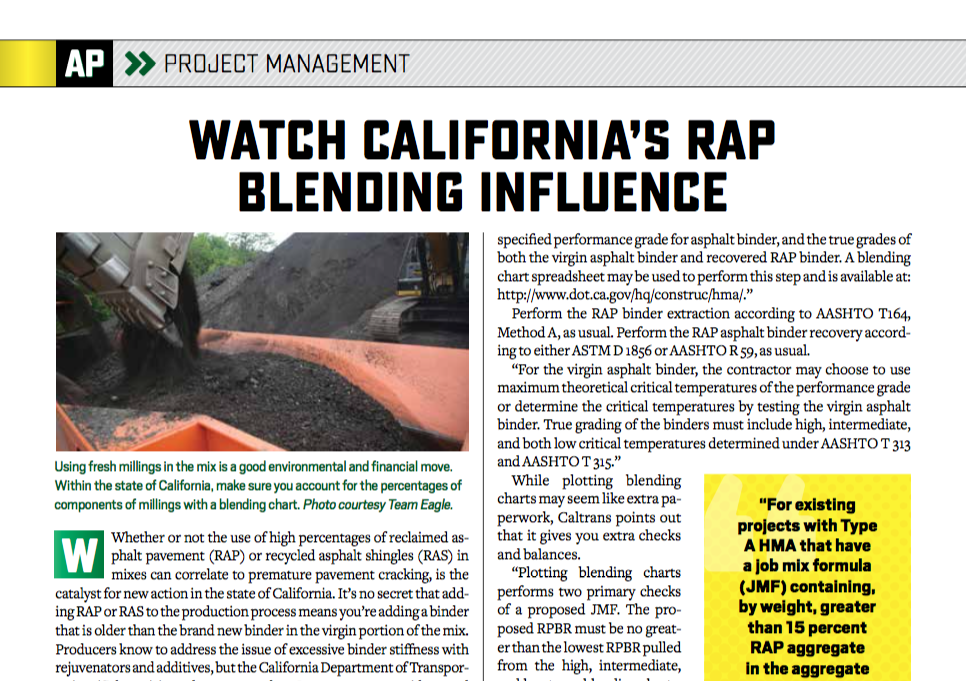Watch California’s RAP Blending Influence
BY Sandy Lender

Whether or not the use of high percentages of reclaimed asphalt pavement (RAP) or recycled asphalt shingles (RAS) in mixes can correlate to premature pavement cracking, is the catalyst for new action in the state of California. It’s no secret that adding RAP or RAS to the production process means you’re adding a binder that is older than the brand new binder in the virgin portion of the mix. Producers know to address the issue of excessive binder stiffness with rejuvenators and additives, but the California Department of Transportation (Caltrans) issued a memorandum June 22 to ensure widespread implementation of “a non-standard special provision” for mixes that its officials consider high percentages. In the state of California, contractors are now required to provide blending charts to show exactly how much binder is recovered and how much binder is new.
From the memo: “For existing projects with Type A HMA that have a job mix formula (JMF) containing, by weight, greater than 15 percent RAP aggregate in the aggregate blend, a change order must be executed to require the contractor to produce asphalt binder blending charts. The blending charts will show the maximum allowable RAP pavement binder ratios (RPBR) that may be used given the project’s specified asphalt binder, and the properties of the virgin binder and recovered binder from RAP.”
Making the blending chart shouldn’t be overly complex, because the lab tech is already performing tests and quality control to make your mix the best it can be. He or she should already be using the Asphalt Institute’s MS-2 manual, which Caltrans requires for creating the blending charts. “The blending charts must be prepared following the procedures in Section 11.4 of the seventh edition of MS-2 Asphalt Mix Design Methods by the Asphalt Institute.”
Now the lab tech will take that a step—or two or three steps—further to satisfy the requirement of charting the high-RAP mixture’s percentages/properties. According to the memo from Caltrans: “Producing the blending charts requires plotting the direct shear rheometer and bending beam rheometer specified limits based on the project specified performance grade for asphalt binder, and the true grades of both the virgin asphalt binder and recovered RAP binder. A blending chart spreadsheet may be used to perform this step and is available at: http://www.dot.ca.gov/hq/construc/hma/.”
Perform the RAP binder extraction according to AASHTO T164, Method A, as usual. Perform the RAP asphalt binder recovery according to either ASTM D 1856 or AASHTO R 59, as usual.
“For the virgin asphalt binder, the contractor may choose to use maximum theoretical critical temperatures of the performance grade or determine the critical temperatures by testing the virgin asphalt binder. True grading of the binders must include high, intermediate, and both low critical temperatures determined under AASHTO T 313 and AASHTO T 315.”
While plotting blending charts may seem like extra paperwork, Caltrans points out that it gives you extra checks and balances.
“Plotting blending charts performs two primary checks of a proposed JMF. The proposed RPBR must be no greater than the lowest RPBR pulled from the high, intermediate, and low temp blending charts, and the percent RAP aggregate in the aggregate blend must be no greater than the maximum RAP aggregate in the aggregate blend as determined by the lesser of the maximum RPBR and JMF, or 25 percent. The blending chart spreadsheet performs these checks.”
In the state of California, if you have questions about your blending charts, you can contact Kee Foo, who is in the division of maintenance, at kee.foo@dot.ca.gov. Or you can contact Pete Spector, who is in the division of construction, at pete.spector@dot.ca.gov. Outside the state of California, you can review the blending chart spreadsheets at the link above and use this for an extra quality control measure in your operations.
